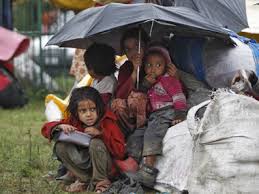FEAR OF EPIDEMIC, DISEASES LOOMING LARGE AS JAMMU AND KASHMIR LIMPS OUT OF CRISIS; ANGER AGAINST STATE GOVERNMENT MOUNTS
Fears of the aftermaths of the floods are looming large
NEW DELHI: The worst catastrophic disaster in many decades in Jammu and Kashmir wherein over 200 people have died, tens of thousands still stranded and hundreds missing has been described as a “man-made” disaster by the Bombay Natural History Society (BNHS).
Terming the J&K floods as an ecological disaster, the BNHS said that the loss of wetlands, which acts as a buffer for floods, aggravated the situation which led to the current level of destruction.
Dr Asad Rahmani, an eminent naturalist and BNHS director issued a statement on Tuesday saying, “This can be termed as an ecological disaster. The disastrous damage caused to life and property could have been minimised if the large number of wetlands that once existed in the valley, had been preserved” and further demanded for the Wetland Conservation Act.
Ten days after the floods ravaged J&K, waters are receding in most areas though many houses and roads are still inundated with the floodwaters.
Around 80% of the main city of Srinagar was still under more than three or four metres of water on Tuesday, with most residents now staying in shelters or with relatives on higher ground.
The Army, along with the Air Force, NDRF and the Navy (which has been deployed for the first time) have been avidly carrying out rescue and relief operations much before the government provided any help. The local Kashmiris took the lead in mounting serious rescue operations from the first day itself.
More than 184,000 people have been rescued by the multi-agency operations which are in full-swing; but now, the fears of the aftermath 0f the floods are looming large.
On the one hand, the fear of an epidemic and the outbreak of waterborne diseases is impending; on the other, the whole state, particularly Srinagar is facing an overall health care crisis.
Doctors have already seen cases of diarrhoea, skin allergies and fungus, and are worried that the stagnant waters are creating conditions for the outbreak of serious diseases.
With innumerable distended livestock floating across the waterlogged region and tens of thousands of people living in temporary shelters provided to them by the Army,health experts and even the officials are worried about the immediate future.
Although, the officials say that they have been preparing for an outbreak of waterborne diseases, not much is evident on the ground.
In Srinagar, the three major hospitals of the city continue to remain closed with the government having taken no initiative at all to open these even as the numbers of sick rise with every passing day. The lone childrens hospital of the Valley, the GB Pant hospital, is working overtime to treat patients with the doctors overworked and medicines in short supply.
Six medical camps and 80 medical teams have already treated around 53,000 patients, according to the Indian army but this doesn’t provide specialised treatment which is required presently.
It is true that health workers, sewage pumps, water filters, water purifying tablets and generators to supply the relief camps and field hospitals with electricity have been provided, but the state government cannot be seen anywhere to coordinate this effort.
The communication lines that were disrupted since the onslaught of the deluge are being restored. The communication system had failed on a massive scale with most of the mobile towers under water for 4-5 days.
Of the nearly 12,306 base trans receivers and networks, 1,681 had been submerged.
However, the service providers are trying to restore their network with many providing people with additional talk time.
Aircel, for instance, also has services like ‘Aircel Locate’ which helps in locating the poeple without any cost.
Jammu-Srinagar national highway was restored by the Army on Tuesday after sustained efforts for nearly a fortnight by the Border Road Organisation and the Army engineers.
Work is now on to construct a new bridge over the Ans River near Budhal which will be completed in two days and also to construct a bridge at Kotranka in order to restore the road link between Rajouri and Reasi districts.
It was reported that the J&K police and the Srinagar Municipal Corporation (SMC) were visible on the streets for probably the first time since the floods began.
While the police personnel could be seen on the roads in the Valley, the SMC hired trucks in order to collect and dispose of garbage that had accumulated over the past days.
The road connecting Srinagar to South Kashmir was also opened and both the public and private transport began to ply on the roads.
Jammu and Kashmir which was entirely crippled by these devastating floods is beginning to move again with some regions like Srinagar recovering quickly while others like South Kashmir crawling out of the crisis.
The anger and frustration against the government is all too evident throughout the state.





